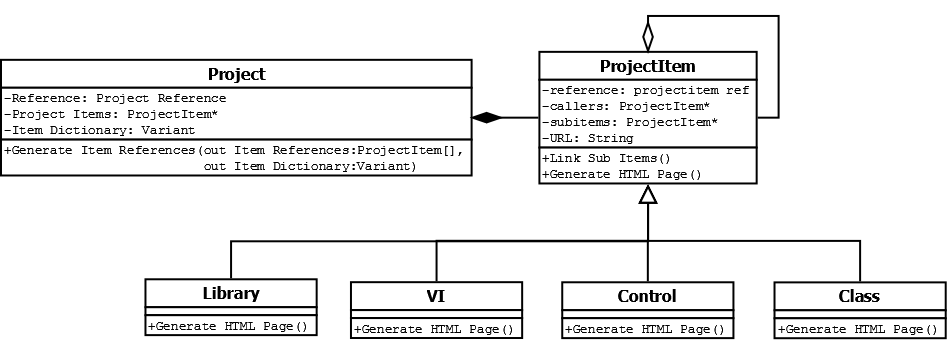Search the Community
Showing results for tags 'oop composition'.
-
I have been working on some basic experimentation with OOP and want to apply it to a project that I have wanted to do for a while. At university I created a VI that would traverse a LabVIEW project, print a HTML page for each subVI etc. and then create a home page and link the pages together. It worked quite nicely but when I started to look at additional features or customisation I knew that it was not scalable enough and I would treat that as a prototype and start from scratch. That was 2 years ago now and I am finally looking at it again! I thought back then that OOP is going to be the best way to approach this and it's a good chance for me to write a largish OOP application (I have used bits before and understand practicalities but not some of the higher level design priniciples). Attached is an initial class diagram which is currently fairly simple. The basic idea is: The project class to generate my ProjectItem classes (This will be the parent class for various item types). It will generate these as references (I want to only generate a single page for each project item) and store them in a dictionary. For this I have been told that variant attributes are actually highly optimised. I will use scripting or similar to find each items subitems (e.g. SubVIs) and generate an array of these references. As each subitem is found it will identify itself as a caller to that subitem. Then I just have to generate the pages... My thoughts are that each project item will have an array of DVRs to it's callers and one for it's subitems so that any methods for generating pages should have all the information they need. This however is naughty according to LVOOP as it is a recursive type. I see 2 potential ways around this: The children of project items contain their own arrays of DVRs to project items. I believe this is allowed however it seems like I will then be repeating functionality accross these child classes. I can "override" LabVIEW and cast the DVRs to I32 or similar and do it how I want. The thing is in my experience that LV has often known better and when I have forced it to do something like that it has come back to bite me in the arse! Having just been doing a bit of reading, there may be a 3rd. Is this a case for some sort of delegation pattern? I would be interested if anyone had any suggestions for best practice on this or whether there is another option that I am missing. I have just thought of a 4th possibility would be rather than using the arrays of objects and dictionary would be to use a database implementation instead but that feels like overkill for this.


